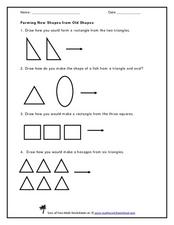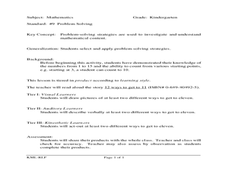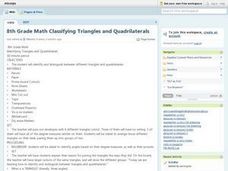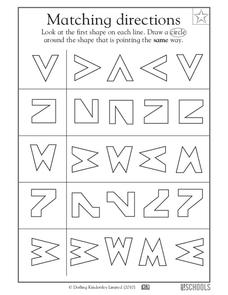Curated OER
Count by 5's Teaching Idea
Creating while learning is great for visual, spacial, and kinesthetic learners. First graders can use the provided quilt squares to construct their very own count by 5 quilt. Each quilt square shows a picture of a hand with a 5s number...
Houghton Mifflin Harcourt
Use Money
Give this to your second and third grade class to practice counting coins. There are six word problems given. Consider giving each learner a few dollars in coins to help kinesthetic learners. Also consider reviewing the word fewer before...
ISTE
Let's Count to 10
Learners form groups of zero to 10 objects. They connect number names to groups, compose and decompose numbers, and use numerals to record the size of a group. The comprehensive, eight-component mini unit addresses the needs of visual,...
Curated OER
Money
Which coins do you need? Scholars are faced with a challenge: using only three coins they must find the exact amount needed for six items. The coins are standard US currency and are pictured at the top, however their value is not listed....
Curated OER
And 1 More Makes...
If we add one more, how many will we have? Beginners to addition practice this skill using images and counting as they draw one more sock to each set and record the new total. There are three of these followed by four more similar...
Curated OER
And 5 More Makes...
By drawing five more objects to existing sets, scholars begin to understand the concept of addition. They count pails and draw five more, totaling them and recording the sums. There are three of these followed by four more similar...
Curated OER
Fractions of Shapes
Explore fractions visually through segmented shapes. Scholars examine sets of shapes and shade in the given fraction. Each shape is divided into the same number of segments as the denominator of the desired fraction, so beginners aren't...
Curated OER
Expanded Shells
Practice expanded and standard notation in this beach-themed addition activity. You will need to cut out the shell templates, which are in three groups: ones, tens, and hundreds. Learners choose one from each group, then use the...
Illustrative Mathematics
Counting by Tens
With this daily counting activity, your kindergartners will master counting in sequence automatically from 0 to 100, and will count in multiples of ten to 100. With the whole class, count to 100. With each number, learners will whisper...
Curated OER
Forming New Shapes from Old Shapes
Shapes can be joined together to make new shapes! Young geometers experience this phenomenon as they examine four shape challenges in this worksheet. Scholars create a rectangle from two right triangles and a fish from an oval and a...
University of Exeter
Angles and Turns
Junior geometers investigate the concepts of angles and turns using straws to perform a hands on activity. This is helpful for kinesthetic learners who have a hard time with mathematics. The lesson plan includes the dialogue to be used...
K-5 Math Teaching Resources
Fraction Strips
Reach out to your visual and kinesthetic learners with this set of printable fraction strips. Not only is this resource a great way to develop children's fractional number sense, it's bound to capture their engagement as well.
Curated OER
Inequalities and The Order of Operations
Middle and high schoolers investigate how to solve inequalities. The lesson has a good guide for taking pupils through a direct instruction of the concept. You can use counting tiles in order to help kinesthetic learners.
Curated OER
Extending our Knowledge of Place Value
Students demonstrate their knowledge of place value through auditory, visual, and kinesthetic channels. In this place value lesson, kinesthetic learners work with a partner using both sets of hands to represent 2 digit numbers. Visual...
Curated OER
Human Coordinate Plane: An Array of Desks
Use a kinesthetic activity to elucidate ordered pairs and coordinate planes. Arrange desks in a square array and distribute to learners cards with ordered pairs based on the locations of their seats. By having various groups of learners...
Curated OER
Measuring our Hands!
How do we compare? Get your scholars measuring using this interactive and kinesthetic math activity. First, learners compare something (you announce- could be index finger, palm, feet, etc.) to classmates. Consider having them record...
Curated OER
Learning Styles in Math
Students discover which learning style works best for them in a math setting. In this math comprehension lesson, students create different combinations of numbers that equal the sum of 11. Students determine if they are better visual,...
Curated OER
Adding and Subtracting Integers
Middle schoolers use discs in order to add and subtract integers. There are manipulatives present so kinesthetic learners can access the curriculum. They also review the concept of the opposite of positive and negative numbers.
Curated OER
Numeral Dough Mats
Kinesthetic learners will have a great time with numbers as they play with colored dough using these numeral recognition mats. The resource outlines number 0-9, each large enough for a full-page. Print them out and laminate, then use in...
Curated OER
8th Grade Math Classifying Triangles and Quadrilaterals
Eighth graders engage in a lesson that is about classifying polygons with the focus being upon specific triangles and quadrilaterals. They conduct activities using cutouts for kinesthetic learners to help make connections while...
Curated OER
Matching Directions
These shapes are pointing all over the place. Learners examine rows of crazy shapes to find the one pointing in the same direction as the first in the row. Keep in mind, these aren't the shapes your mathematicians are used to. Because...
Curated OER
Brother In The Box
Middle schoolers investigate the concept of finding the area of a parallelogram. The lesson plan uses a story that is told as an illustration to help straighten the confusion associated with the concept. Students could construct...
EngageNY
Positive and Negative Numbers on the Number Line—Opposite Direction and Value
Make your own number line ... using a compass. The first installment of a 21-part series has scholars investigate positive and negative integers on a number line by using a compass to construct points that are the same distance from zero...
Super Teacher Worksheets
Prime and Composite
Factoring is an essential component in algebra, and this worksheet prepares learners with a quick reference guide and examples. After they find all the factors, they decipher whether the number is prime or composite.

























